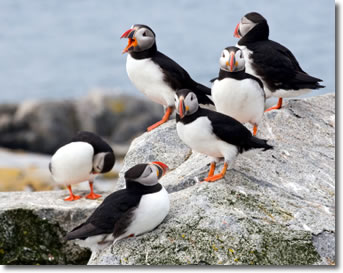THE PUFFINS OF EASTERN EGG ROCK
 It’s a most unpromising place, seven acres of granite bedrock rising, at its highest point, just 17 feet above the waters of Maine’s Muscongus Bay. With no trees and no shelter, save the 12 by 12-foot cabin at its center, Eastern Egg Rock is one of literally thousands of tiny islands formed by the retreating Laurentide Ice Sheet roughly 10,000 years ago.
It’s a most unpromising place, seven acres of granite bedrock rising, at its highest point, just 17 feet above the waters of Maine’s Muscongus Bay. With no trees and no shelter, save the 12 by 12-foot cabin at its center, Eastern Egg Rock is one of literally thousands of tiny islands formed by the retreating Laurentide Ice Sheet roughly 10,000 years ago.
Uninviting though it is, Eastern Egg Rock is also the site of a miracle of sorts. Once plentiful on the island, the Atlantic puffin had disappeared by the end of the 19thcentury, victim to hunters who killed the birds for their feathers, then fashionable on women’s hats. Thanks to the vision of a single man, however, the puffins are there once more, and thriving.
In 1973 biologist Stephen Kress began relocating puffin chicks from Newfoundlandto Eastern Egg Rock. But the process wasn’t as simple as it sounds. Once fledged, young puffins leave their nesting ground in darkness—the better to thwart the always hungry gulls—and go to sea for as long as two or three years. At some point, instinct tells them to return to their birthplace to breed. Assuming, of course, they can find it.
And so to help the birds recognize Eastern Egg Rock as home, Kress made dozens of puffin decoys out of wood and “perched” them on the boulders, hoping that the real puffins would see them and be tricked into coming ashore. It worked. As of the summer of 2009, 107 pairs of Atlantic puffins were nesting on Eastern Egg Rock.
Miracle? Yes, the kind of miracle that takes patience, dedication, and vision to see the promise in a most discouraging place.